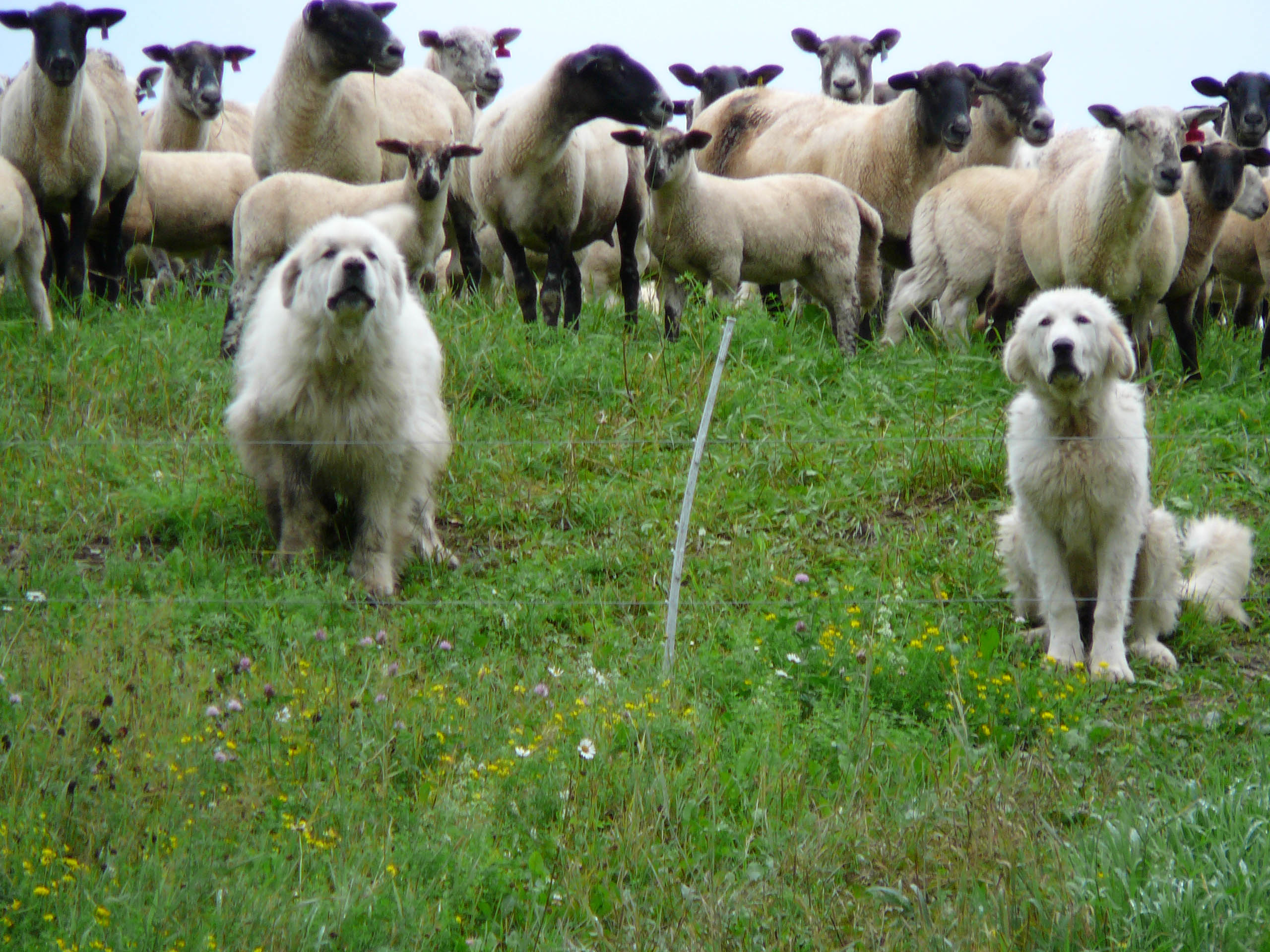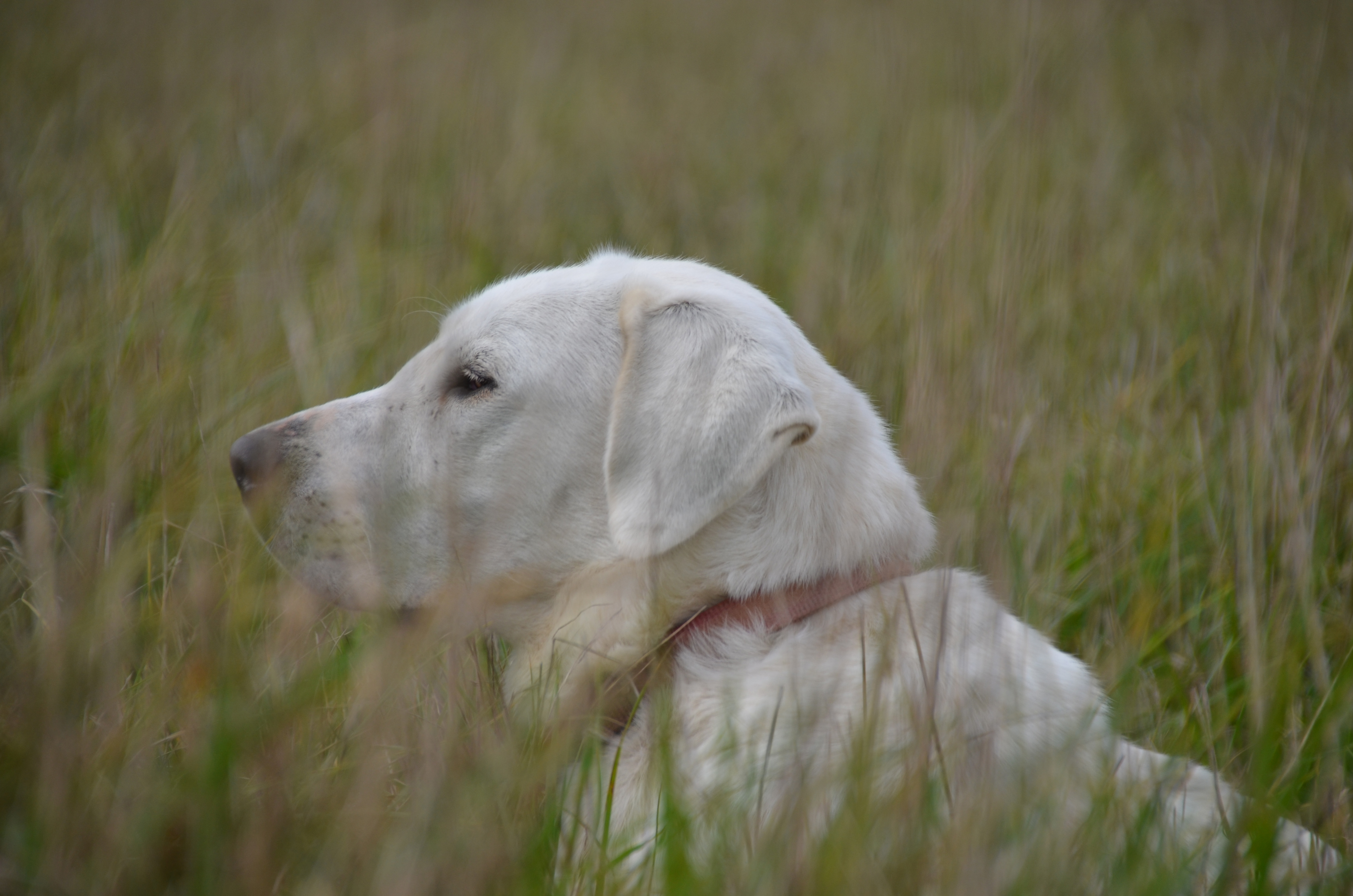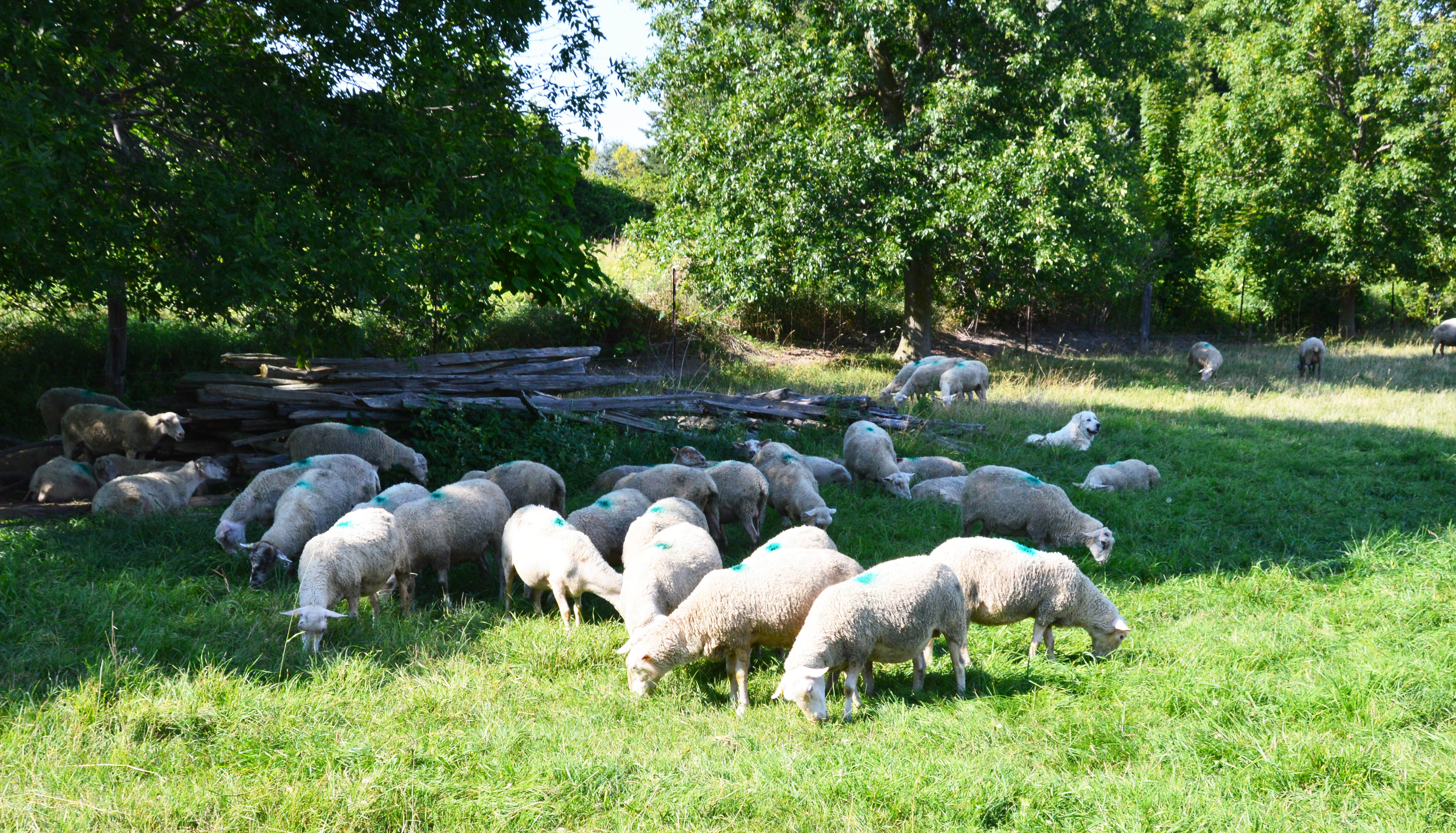Selection and training
ISSN 1198-712X, Published March 2022
Overview
There are at least 40 breeds of livestock guardian dogs (LGDs) used around the world
This fact sheet discusses considerations for selecting LGDs and recommendations for raising them to be effective guardians on a sheep or goat operation.
These companion factsheets provide further information for producers seeking to add LGDs to their operation:

Characteristics of LGDs
The behaviour of all animals is due to a combination of their genetics and the environment in which they live and have been raised. According to Coppinger et al., LGDs must display three main behavioural traits to be effective: trustworthiness, attentiveness and protectiveness
- reared with the stock they will guard from birth or a young age
- bond well with the herd or flock
- stay near and are attentive to the herd or flock
- work independently
- maintain a perimeter and display protective behaviour against predators
- remain within the pasture or farm boundaries
- do not chase vehicles, bicycles or people
- are physically sound, have appropriate body condition, conformation and health for longevity
These traits in LGDs can render them less effective:
- reared away from stock (for example, re-homed pets or farm dogs)
- overly bonded with the shepherd
- leave the herd or flock unprotected from dusk until dawn when predators are most active
- display overly aggressive behaviours towards humans, livestock or non-predatory wildlife
- chase vehicles, bicycles or people on municipal roadways
- do not adequately deter predators
- chase, startle or play with the stock
- roam outside of the pasture or farm boundaries
- are chronically lame, have poor conformation or health
Selecting LGDs
Breed
LGDs have been specifically bred for thousands of years to bond with stock, work independently from humans and have strong protective instincts and low desire to chase the livestock they are guarding
Popular LGD breeds are typically similar in appearance (Figure 2)
There has been little evidence that any breeds are more effective at mitigating predation, however, some differences in guarding behaviour have been reported

| Factors | Breed Great Pyrenees | Breed Maremma | Breed Akbash | Breed Anatolian | Breed Komondor |
|---|---|---|---|---|---|
| Number of dogs evaluated | 437 | 20 | 62 | 56 | 138 |
| Rated very effective | 71% | 70% | 69% | 77% | 69% |
| Rated somewhat effective | 22% | 20% | 22% | 13% | 1% |
| Rated not effective | 7% | 10% | 9% | 10% | 12% |
| Rated an economic asset | 83% | 84% | 71% | 82% | 82% |
| Aggressive to predators | 95% | 94% | 100% | 96% | 94% |
| Aggressive to dogs | 67% | 94% | 92% | 86% | 77% |
| Aggressive to sheep | 7% | 20% | 20% | 14% | 24% |
| Aggressive to people | 4% | 5% | 6% | 9% | 17% |
Adapted from Green and Woodruff (1988).
Sex
Results from many LGD studies have reported no difference in the effectiveness of male and female dogs, although some producers have a personal preference
It is generally recommended that dogs not intended for breeding be spayed or neutered because female dogs are not protecting the herd or flock when kenneled during heat cycles or rearing puppies, and intact dogs may be more likely to wander. The decision to spay or neuter LGDs, and the appropriate age to do so, should be made in consultation with the flock or herd veterinarian.
Age
Young LGDs do not become fully effective until they are about 2 years old
When purchasing LGDs, it is generally possible to buy puppies (8–10 weeks), adolescents or adults. The price to purchase a dog will increase with age, as the breeder invests more resources into their development, but the risk of purchasing an unsuitable dog may be lower.
Buyers looking to purchase their first LGD should consider purchasing an adult dog to offer more immediate protection to the flock or herd. New LGDs should be added to the operation to achieve an even distribution of ages. This will reduce labour requirements for training as younger dogs will learn from the older dogs. Purchasing several puppies of a similar age is generally not recommended because it will increase labour requirements for the producer and older dogs on the operation, and make maintaining an appropriate distribution of ages more difficult.
Breeders
Purchasing from a reputable breeder is generally more important than the breed, sex or age of an LGD prospect. For those that are new to the use of LGDs, it’s important to find a breeder that can provide on-going support. It’s best to look for breeders that face the same types of predation challenges (such as, species and pressure). It’s also worth considering any challenges for the use of LGDs on a producer’s own operation that might not be a factor for the breeder. For example, LGDs roaming or with defensive responses towards humans may not be tolerated for operations near populated areas.
When evaluating breeders, look for LGDs where
- both parents are working guardian animals of traditional LGD breeds (or crosses between LGD breeds)
- breeders bond their puppies with stock from a young age
- both breeding stock and puppies are in good health (for example, vaccinated, dewormed, routine veterinary care and possibly even hip and eye certification for breeding stock)
It’s important to be selective because the purchase, training and care of an LGD add up to a significant investment.
Raising effective LGDs
General training principles
LGD breeds have innate guarding traits, but they will all require some level of training, some more than others. Training an LGD, like any animal, is most effectively done by rewarding desired behaviours and management of the environment to prevent undesirable behaviours. It is much easier to prevent a problem by supervision and management than it is to solve a problem later. It is a well-established fact that dogs learn much more quickly through reinforcement (such as praise, rewards, access to resources) than they do from punishment (such as scolding). However, inappropriate behaviours (such as chasing stock, roaming) must be interrupted immediately.
It is generally useful to teach LGD some basic obedience commands (such as “come,” “sit,” “down,” “stay,” “leave it”) and accustom the dog to being handled by different people, to walk on a leash and to tolerate car rides. This will reduce the stress of care and veterinary visits. Mealtimes are a great opportunity to practice and reinforce these behaviours.
Traditionally, producers have avoided interacting with their LGDs out of concern for their ability to bond with the stock. Today, many producers recognize that brief interaction, praise and petting are beneficial for LGD care and training.
It’s important to recognize that LGDs are not only predation mitigation tools, they are also animals with their own needs. Not all dogs will be suited to the task, and LGDs that are not performing adequately may be more suited to another operation or lifestyle. They also need adequate time to rest and relax to be most effective at their job.
Bonding with livestock
It’s important that LGD puppies are reared with livestock from a young age to promote bonding and appropriate behaviour towards the flock or herd (Figure 3). Researchers have found that puppies reared with livestock by 3 months of age have a higher rate of success as LGDs than those placed with stock after this age
- Puppies have a critical period from about 8–16 weeks where social attachments are made, and they learn to be attentive to livestock.
- From around 4 months to 1+ years, the young LGD learns to be trustworthy with the stock, and many wander or chase the stock as they learn appropriate behaviours.
- At approximately 1 year, the LGD will mature and exhibit more protective behaviour, at which point they generally start to become effective guardians.
Young LGD puppies should be placed in bonding pens either by themselves or in pairs from about 8 weeks to 5 months of age. Bonding pens should be small — 14 m2 (about 150 ft2) — with 3–6 stock and an area that is inaccessible to the stock for the puppies to feed and rest

Boundary training
Roaming outside of pasture or farm boundaries is one of the most common problems producers with LGDs must manage. Dogs naturally have large territories or “home ranges.” In Australian range conditions, LGDs were found to have a core home range, meaning the area in which the dogs spent 50% of their time, of 4–252 ha and the full range of the dogs was up to 2 km outside of the sheep pastures
Roaming dogs create conflicts with neighbours and motorists and leave stock unprotected. Dogs that wander are also at a higher risk of being injured or killed. In a study from the Livestock Guardian Dog Project, 48% of total deaths of dogs managed on farms were attributable to accidents (such as disappearing, being hit by vehicles), and many of these causes could be attributable to dogs roaming
The boundary of an LGD may be within a specific pasture or across the farm property, depending on the operation. Containing dogs within physical boundaries (such as, closed farm gates, electric or woven wire fencing in good repair) will reduce the ability of LGDs to leave desired areas and is a critical first step towards boundary training. Taking new LGD adults or puppies on regular perimeter walks of your property or pastures may also help teach them to respect your boundary fences.
Conclusion
LGDs can be a valuable addition to a predation mitigation strategy for some operations. However, selecting the right dogs and raising them appropriately are both critical to their overall effectiveness as guardian animals. Ineffective dogs may cause as many problems, by roaming, chasing the stock and more, as they solve by mitigating predation. Choose dogs of traditional LGD breeds or crosses where both parents are working LGDs, and ensure that they are reared with stock from a young age to promote appropriate behaviours towards the herd or flock. Producers interested in purchasing their first LGD are encouraged to consult experienced shepherds or LGD breeders for additional information and support.
This fact sheet was written by Erin Massender, small ruminant specialist, OMAFRA.
Footnotes
- footnote[14] Back to paragraph Gehring, T.M., VerCauteren, K.C. and Landry, J-M. (2010). Livestock protection dogs in the 21st century: Is an ancient tool relevant to modern conservation challenges?. USDA National Wildlife Center – Staff Publications. 919, 299-309.
- footnote[15] Back to paragraph Coppinger, R., Coppinger, L., Langeloh, G., Gettler, L. and Lorenz, J. (1988). A decade of use of livestock guarding dogs. Proceedings of the Thirteenth Vertebrate Pest Conference (1988). 43, 209-214.
- footnote[16] Back to paragraph Coppinger, L. and Coppinger, R. (2014). Dogs for herding and guarding livestock. In T. Grandin (Ed.), Livestock Handling and Transport, 4th Ed. (pp. 245-260). CAB International.
- footnote[17] Back to paragraph Smith, M.E., Linnell, J.D.C., Odden, J. and Swenson, J.E. (2000). Review of methods to reduce livestock depredation: I. Guardian animals. Acta Agriculturae Scandinavica, 50, 279-290.
- footnote[18] Back to paragraph Green, J.S. and Woodruff, R.A. (1988). Breed comparisons and characteristics of use of livestock guarding dogs. Journal or Range Management, 41(3), 249-251.
- footnote[19] Back to paragraph Redden, R.R., Tomeček, J.M. and Walker, J.W. (2015). Livestock guardian dogs. Texas A&M AgriLife Extension Service, 1-8.
- footnote[20] Back to paragraph Costanzo, B., Redden, R. and Walker, J. (2020). How to select a livestock guardian dog puppy. Texas A&M AgriLife Extension Service.
- footnote[21] Back to paragraph Lorenz, J. and Coppinger, L. (2002). Raising and training a livestock-guarding dog. Oregon State University Extension Service. (Original work published in 1996).
- footnote[22] Back to paragraph Van Bommel, L. and Johnson, C.N. (2014). Where do livestock guardian dogs go? Movement patterns of free-ranging Maremma Sheepdogs. PloS ONE, 9(10), e111444, 1-12.
- footnote[23] Back to paragraph Lorenz, J.R., Coppinger, R.P. and Sutherland, M.R. (1986). Causes and economic effects of mortality in livestock guarding dogs. Journal of Range Management, 39(4), 293-295.